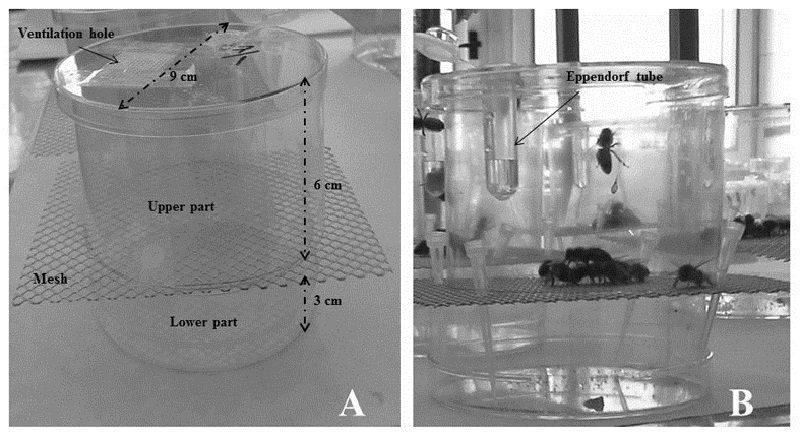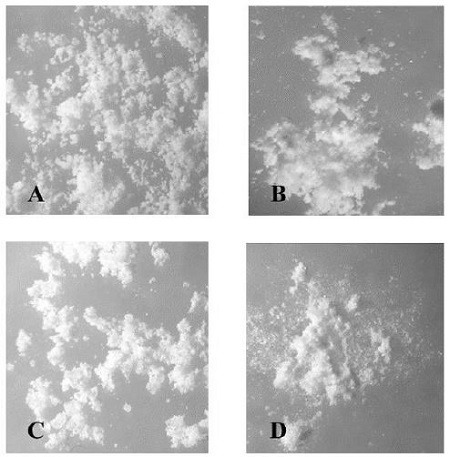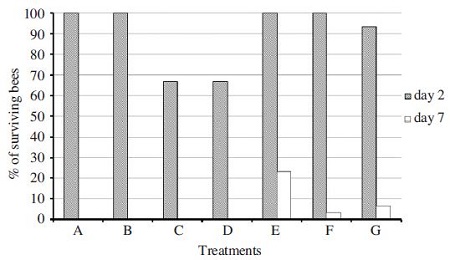
Impacts of Intensive Dusting or Spraying with Varroa Control Materials on Honey Bee Workers and Drones
Abstract
One of the safest methods to reduce Varroa infestation in honey bee colonies is the use of mechanical methods. Dusting or spraying honey bees with some materials (e.g. powdered sugar or oxalic acid solution) can be considered as safe mechanical methods. In this study, the effects of dusting or spraying on the survival rate of honey bee workers and drones were investigated. The results showed that using dusting (with powdered sugar, wheat flour, talcum powder or magnesium carbonate) or spraying (with sugar syrup, or mix of sugar syrup and oxalic acid) can reduce the survival of honey bees except spraying using sugar syrup. Repeating the use of powdered sugar or mix of sugar syrup and oxalic acid (3%) for one, two or three times showed reduction in the survival rate of workers and drones. The intensive use of dusting or spraying over bees is not recommended. Spraying bees with sugar syrup only or mixed with oxalic acid is advisable during Varroa control than dusting bees with powdered sugar.
Keywords:
Honey bees, Varroa, Intensive, Dusting, SprayingINTRODUCTION
It is well known that Varroa mites, Varroa destructor, are the major destructive parasitic pest to beekeeping. Infestation with these mites can cause damages to honey bee workers and drones, and could lead to death of the colonies. Thus, researchers worldwide have devolved various methods and materials to manage Varroa mite populations as reviewed by Abou-Shaara (2014). The use of dusting with inert materials or spraying with sugar syrup only or mixed with oxalic acid can be considered as safe and costeffective methods. Direct dusting of honey bees with fine sugar had effectiveness in regard to increasing Varroa mites fall (Fakhimzadeh, 2001a). Aliano and Ellis (2005) have developed a method to control Varroa mites from adult honey bees using powdered sugar. Their method was able to drop about 76.7% of mites. However, dusting colonies with powdered sugar has not achieved significant Varroa control level (Ellis et al., 2009). Similarly, powdered sugar technique has been considered as weak control strategy for Varroa mites (Berry et al., 2012). Using powdered sugar to determine the level of infestation with Varroa mites has shown insignificant differences than flotation method (Bak et al., 2009). Other materials can also be used in dusting bees, for example Macedo et al. (2002) have used six materials; wheat flour, talcum powder, corn starch and baking soda beside powdered sugar and fine sugar. It could be said that dusting adult bees has shown acceptable effectiveness towards Varroa control. However, the impacts of using intensive dusting technique using inert materials on the survival of honey bee workers and drones still unknown.
Concerning spraying, mixing sugar syrup with oxalic acid has given more hygroscopic solution and increased mites fall (Milani, 2001). The efficacy of spraying colonies once or twice with a 0.5% oxalic acid solution were of 92.94% and 91.84%, respectively (Toomemaa et al., 2010). The use of 3.0ml of a 2.8% oxalic acid solution can cause effective mite control with minimal impacts on package bees (Aliano and Ellis, 2009). Using oxalic acid as trickling and vaporization was better than using oxalic acid in cellulose strips (Marinelli et al., 2006). Spraying honey bees with oxalic acid caused 86% of mites mortality while sublimation with oxalic acid caused the highest mortality with 97% (Al Toufailia et al., 2015). Therefore, spraying honey bees with sugar syrup mixed with oxalic acid has efficacy in regard to Varroa control. Moreover, sprinkling honey bees with sugar syrup only has shown ability to increases mites fall (Pileckas et al., 2012). So far, the effects of intensive spraying with sugar syrup only or mixed with oxalic acid on honey bees have not been well investigated. Therefore, this study aimed to investigate the impacts of dusting or spraying with different materials on the survival rates of honey bee workers and drones under laboratory conditions. Based on the obtained results specific recommendations are presented towards saving bee health during Varroa control practices.
MATERIALS AND METHODS
Experimental set-up
The experiments were performed at the laboratory of the Institute of Apiculture, VÚŽV, Slovakia during spring 2016. The cages were done by using petri dishes and pieces of plastic sheets. The cages were divided using wire mesh into small (3cm L) and large (6cm L) part (Fig. 1). The cages were provided also with small holes covered with mesh for ventilation and perforated Eppendorf tubes. The tubes were filled with 1 ml of sugar syrup (1 sugar: 1 water) as a food source. The covers of the cages used to open during treatment application. Tested Carniolan honey bee workers, and drones were obtained from the lateral combs. Bees were narcotized by using CO2 before inserting into the cages. The caged bees were left at room temperature (18±1°C) during the experiments.
Impacts of treatments application
Honey bee workers were dusted with powdered sugar, wheat flour, talcum powder or magnesium carbonate (Fig. 2), and were sprayed with sugar syrup (1:1 sugar and water), or mix of sugar syrup and oxalic acid (3%). Total of 6 treatments were compared with control for assessing the adverse effects on bees. For each treatment, 10 worker bees were placed in each cage. Each cage with bees was intensively dusted or sprayed at the rate of 1 grams of test material, and at distance of about 2 cm from the cage. Dusting was done using small plastic jar with perforated bottom while spraying was applied using normal sprayer. Each treatment was replicated for 3 times. Dead bees after 24 hours were photographed and removed from the cage. Also, the live bees were counted daily up to 7 days after treatment.
Impacts of repeated treatments application
Honey bee workers and drones were dusted with powdered sugar or sprayed with sugar syrup mixed with oxalic acid 3% (abbreviated as oxalic solution) for one, two and three times with one day interval. The one day interval was used because the survival of the bees was not high at 18±1°C (temperature of the experiments) as shown by the first experiment. Test bees were dusted or sprayed with oxalic solution (1 gram/treatment). Total 6 treatments (3 for powdered sugar and 3 for oxalic solution) and one control (bees without dusting or spraying) were used in this experiment. For each treatment, 10 workers and 5 drones were placed in each cage. Each treatment was replicated for 3 times. The live worker and drone bees were counted daily up to 7 days after treatment.
Statistical analysis
Arcsine transformed data were analyzed using SAS ver. 9.1.3 (2004). ANOVA procedure was performed and means were compared by Duncan’s multiple range test0.05. Readings of day 5 and 6 were not taken due to vacation periods. Thus, the readings of day 7 were assigned to day 5 and 6 as well during figures preparation to avoid any interruption in the figures.
RESULTS
Impacts of treatments application on workers
Most of bees showed cleaning behavior until 24 hours except talcum powder treatment. The dead bees were found covered with treatment materials (Fig. 3). The impact of treatments on survival of the bees was significant (F=2.99, DF= 6, P=0.008) among the 7 days. Also, the impact was significant at each day from day 2 to 7 (F=6.77, DF= 41, P<0.0001). Bees treated with talcum survived only up to 3 days while those treated with sugar, flour or magnesium were survived up to 5 days (Fig. 4). At the next day after the treatments, % of surviving bees dropped from 100±0.00% to 66.66±17.63, and 66.66± 8.81% in magnesium and talcum treatments respectively (Fig. 4). Bees sprayed with sugar only or with sugar and oxalic were survived up to 7 days (with mean of 23.33±23.33 and 3.33±3.33%, respectively). Bees without any treatment were able to survive up to 7 days with higher percentage (6.66±6.66%) than all treatments except bees treated with sugar syrup. This reflects that all treatments, in general, impacted bee survivability. The treatments according to their impact on bee survival can be arranged in descending order as; sugar syrup, sugar syrup with oxalic, powdered sugar, flour, magnesium and finally talcum.

Pictorial presentation of dead bees relative to dusting or spraying with test materials after 24 hours. A: control group, B: bee dusted with flour, C: bee dusted with sugar syrup, D: bee dusted with talcum, E: bee dusted with magnesium, and F: bee sprayed with sugar syrup mixed with oxalic.
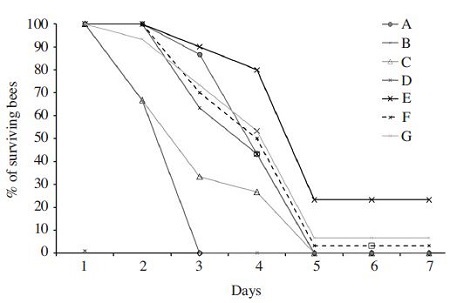
% survival of honey bee workers treated with different materials over 7 days. A: Powdered sugar, B: flour, C: Magnesium carbonate, D: Talcum powder, E: Sugar syrup, F: Sugar syrup an oxalic, G: control.
Impacts of repeated treatments application on workers
The dead bees after the treatments showed that more dust or solution drops were attached to their bodies according to number of repeating the treatments (Fig. 6 and 7). The figures clearly showed the increase of attached materials to bee body with repeating the treatments. The survival of bees was sharply dropped in day 2 and 4 after application of the treatments. All bees treated with powdered sugar treatments showed less survival as compared to the control. However, repetition of using oxalic solution did not impact to the bees. Further, all the bees died by the day 7 except bees treated one time with oxalic solution (10±10%) (Fig. 8). The impact of the treatments including the control group on survival of the bees among the 7 days was not significantly different (F= 0.55, DF=6, P=0.77). However, the impacts were significant at each day from day 2 to 7 (F= 12.57, DF= 28, P<0.0001).
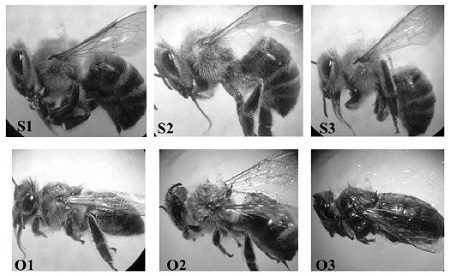
Dead workers after treated 1, 2 or 3 times with powdered sugar (S1, S2, and S3, respectively) or mix of sugar syrup and oxalic acid (O1, O2, and O3, respectively).

The impact of treating worker bees 1, 2 or 3 times with powdered sugar (S1, S2, and S3, respectively) or mix of sugar syrup and oxalic acid (O1, O2, and O3, respectively) on their heads in comparison with control group (C).

Decline in mean% of surviving bees over one week after repeating dusting or spraying. A: one time using powdered sugar, B: two times using powdered sugar, C: three times using powdered sugar, D: one time using oxalic solution, E: two times using oxalic solution, F: three times using oxalic solution, and G: control group.
Impacts of repeated treatments application on drones
A similar trend to this recorded with honey bee workers was also found to the bee drones where more remains of powdered sugar or oxalic solution were found with repeating the treatments (Fig. 9 and 10). At the second day from the treatments, the mean% of surviving drones dropped from 100±0.00% to 6.66±6.66% for bees treated one time with powdered sugar. For the other treatments the % ranged from 13.33 to 53.33%. At the day 4, all drones died except those treated one time with oxalic solution (mean of surviving drones was 13.33±13.33%) as shown in Fig. 11. The impact of treatments including the control group on surviving ability of the bee drones among the 4 days was not significant (F= 0.35, DF= 6, P= 0.91). However, at each day from day 2 to 4 the impacts were significant (F= 5.23, DF= 20, P<0.0001).
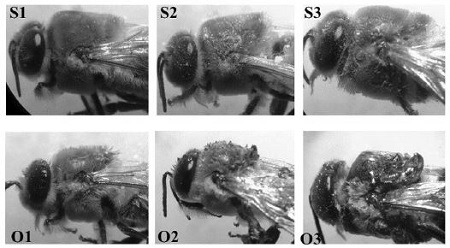
Dead bee drones after the treatments; 1, 2 or 3 times using powdered sugar (S1, S2, and S3, respectively) or mix of sugar syrup and oxalic acid (O1, O2, and O3, respectively).
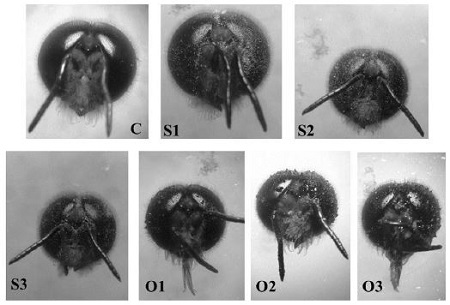
The impact of treating bee drones; 1, 2 or 3 times with powdered sugar (S1, S2, and S3, respectively) or mix of sugar syrup and oxalic acid (O1, O2, and O3, respectively) on their heads in comparison with control group (C).
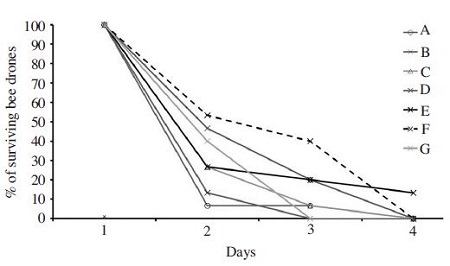
Decline in mean% of surviving bees over 4 days after repeating dusting or spraying. A: one time using powdered sugar, B: two times using powdered sugar, C: three times using powdered sugar, D: one time using oxalic solution, E: two times using oxalic solution, F: three times using oxalic solution, and G: control group.
DISCUSSION
Impacts of treatments application on workers
The study by Macedo et al. (2002) showed that powdered sugar and talcum powder had the highest Varroa control efficacy than fine sugar, wheat flour, corn starch and baking soda. However, the present study showed that treated bees were able to clean their bodies within 24 hours after the treatments and survived up to day 5 except those treated with talcum powder. It is clear that talcum treatment had rapid negative impact on honey bees. These differences might be due to particle shape and size of test materials. Talcum, in particular, might be strongly attached to bodies of the bees and prevented their normal respiration unlike the other used materials. Used materials were detected over bodies of dead bees at the next day. This reflects that intensive dusting or spraying could lead to rapid death of the bees, may be by preventing normal bee respiration. According to Fakhimzadeh (2001a), no sugar particles were found in the spiracles and their tracheal ducts of tergite 2 of treated honey bees (mean of 78 bees) with powdered sugar (5 grams). Perhaps the intensive dusting or spraying in the current study had more negative impact on the respiration of honey bees than using small amount of dusting or spraying materials. Ellis et al. (2009) found that dusting colonies with powdered sugar did not significantly affect the adult bee population or amount of brood than the control group. It could be expected that treating a whole colony with powdered sugar or other inert materials has few damages over them. But as shown in the present study, the group of bees which exposed intensively to dusting materials can be rapidly impacted.
Bees sprayed with sugar syrup only or mixed with oxalic acid were able to survive more than those dusted by different materials. It could be explained by the ability of bees to feed on liquid materials more than inert ones. Thus, bees can clean their bodies easily in case of using sugar syrup alone or mixed with oxalic acid than the presence of fine particles of inert materials. This may be because worker bees were able to utilize sugar syrup as energy source without negative impact on them. The least impact on the survival of bee workers was to sugar syrup followed by sugar syrup mixed with oxalic acid and powdered sugar while flour, magnesium and talcum had the highest negative impact. This can be explained by the role of sugar either syrup or powdered as food to bees and as energy source. Also, bees can feed on sugar without clear problems. The less survival ability of bees treated with sugar syrup mixed with oxalic acid than sugar syrup alone can be explained by the acidity of oxalic acid solution. According to Marinelli et al. (2006), water solution of oxalic acid has high acidity (pH about 1). Also, Aliano and Ellis (2009) found that using 4.6ml or more of oxalic acid (2.8%) caused significant mortality of adult bee (about 1000 bees) in packages. Also, Al Toufailia et al. (2015) found more bee worker mortality when oxalic acid was used as trickling or spraying than as sublimation. Moreover, Toomemaa et al. (2010) found that spraying bees with 1.0 and 1.5% oxalic acid were highly toxic to treated bees. These previous studies support the idea that spraying bees with oxalic acid can cause toxic impacts to the bees, and hence reduce the survival rate of bees.
Impacts of repeated treatments application on workers and drones
The impact of repeating dusting or spraying on honey bee workers or drones showed approximately the same trend. The dead bees after the treatments showed that more dust or solution drops were attached to their bodies according to number of repeating the treatments. All bees treated with powdered sugar treatments showed less survival than the control group and on the contrary with oxalic treatments. These results confirm that dusting bees using powdered sugar can impact workers and drones passively while oxalic acid has somewhat few impacts. This could be explained by the ability of bees to utilize oxalic solution and clean their bodies from it easier than powdered sugar. Accordingly, the study of Toomemaa et al. (2010) showed that spraying bees with 0.5% oxalic acid solution had no noticeable toxicity to treated bees. The impacts of intensive dusting on the survival of bees can not be easily noticed under field conditions. For example, the study of Fakhimzadeh (2001b) showed no negative impacts of dusting colonies with powdered sugar (with 10 to 20 grams) three times at different intervals (3 days, one week and two weeks) on colony development than control colonies. It is expected that during colonies treatment with powdered sugar some bees are more exposed to dust than others and can be negatively impacted as shown in the present study.
Similarly for bee drones, using oxalic treatments caused less negative impacts on the survival rates than using powdered sugar. Also, treated drones one time with oxalic solution survived for longer period than those treated with other treatments. But, most drones survived only up to day 4 while workers were able to survive up to day 7. This could be explained by the less ability of drones to clean their bodies due to their large body size and short tongues. It is expected also that treated workers were not able to clean drone bodies or even to feed them. Therefore, drones survived less than workers. The study of Fakhimzadeh (2001a) showed that using CO2 to anesthesia honey bees had no impact on the efficacy of sugar dusting. Therefore, it is not expected that using CO2 in the present study impacted dusting or spraying results. The short survival period (up to 7 days) of bees in the present study could be explained by the used experimental temperature of 18±1°C. This temperature is less than the optimum one in the colonies (about 34°C).
CONCLUSION
The study highlighted the intensive use of dusting or spraying over honey bees can reduce their survival ability and is not preferable. During dusting or spraying application, it is strongly advised to avoid exposure of small group of bees to high amounts of treatment materials. Further studies towards developing devices that could equally distribute small amounts of dusting or spraying materials over the bees are recommended. The use of sugar syrup only or mixed with oxalic acid could be advised as less harmful to honey bees during Varroa control than powdered sugar. In light of this study, it is better to avoid the exposure of the queens to the dust or spray materials to ensure their safety and to avert any hazards to them. Further studies on the effects of dusting or spraying on honey bee workers and drones at different ages and on bee queens are recommended.
Acknowledgments
Thanks are presented to the National Scholarship Program (NSP) for supporting the research, and stay of Dr. Hossam Abou-shaara in Slovakia. We would like also to thank Ing. Pavel Kantik and Ing. Robert Nadazdy for their kind assistance during the research.
References
- Abou-Shaara, H.F., (2014), Continuous management of Varroa mite in honey bee, Apis mellifera, colonies, Acarina, 22(2), p149-156.
-
Al Toufailia, H., L. Scandian, and F.L. Ratnieks, (2015), Towards integrated control of varroa: 2) comparing application methods and doses of oxalic acid on the mortality of phoretic Varroa destructor mites and their honey bee hosts, J. Apic. Res, 54(2), p108-120.
[https://doi.org/10.1080/00218839.2015.1106777]

-
Aliano, N.P., and M.D. Ellis, (2005), A strategy for using powdered sugar to reduce varroa populations in honey bee colonies, J. Apic. Res, 44(2), p54-57.
[https://doi.org/10.1080/00218839.2005.11101148]

-
Aliano, N.P., and M.D. Ellis, (2009), Oxalic acid: A prospective tool for reducing Varroa mite populations in package bees, Exp. Appl. Acarol, 48, p303-309.
[https://doi.org/10.1007/s10493-009-9240-8]

- Bak, B., J. Wilde, M. Siuda, and M. Kobylinska, (2009), Comparison of two methods of monitoring honeybee infestation with Varroa destructor mite, Ann. Warsaw Univ. Life Sci.-SGGW, Ani. Sci, 46, p33-38.
-
Berry, J.A., O. Afik, and M.P.N. IV, K.S. Delaplane, (2012), Revisiting powdered sugar for varroa control on honey bees (Apis mellifera L.), J. Apic. Res, 51(4), p367-368.
[https://doi.org/10.3896/IBRA.1.51.4.14]

-
Ellis, A.M., G.W. Hayes, and J.D. Ellis, (2009), The efficacy of dusting honey bee colonies with powdered sugar to reduce varroa mite populations, J. Apic. Res, 48(1), p72-76.
[https://doi.org/10.3896/IBRA.1.48.1.14]

-
Fakhimzadeh, K., (2001a), Effectiveness of confectioner sugar dusting to knock down Varroa destructor from adult honey bees in laboratory trials, Apidologie, 32, p139-148.
[https://doi.org/10.1051/apido:2001119]

-
Fakhimzadeh, K., (2001b), The effects of powdered sugar Varroa control on Apis mellifera colony development, J. Apic. Res, 40(3-4), p105-109.
[https://doi.org/10.1080/00218839.2001.11101058]

-
Macedo, P.A., J. Wu, and M.D. Ellis, (2002), Using inert dusts to detect and assess Varroa infestations in honey bee colonies, J. Apic. Res, 41(1-2), p3-7.
[https://doi.org/10.1080/00218839.2002.11101062]

- Marinelli, E., G. Formato, G. Vari, and F.M. De Pace, (2006), Varroa control using cellulose strips soaked in oxalic acid water solution, Apiacta, 41, p54-59.
-
Milani, N., (2001), Activity of oxalic and citric acids on the mite Varroa destructor in laboratory assays, Apidologie, 32, p127-138.
[https://doi.org/10.1051/apido:2001118]

- Pileckas, V., G.J. Švirmickas, V. Razmaitė, and M. Paleckaitis, (2012), Efficacy of different ecological methods for honeybee (Apis mellifera) Varroa prevention in spring, Veterinarija ir Zootechnika, 59(81), p65-70.
- SAS, (2014), The SAS System, Version 9.1.3, SAS Institute, Cary. NC, USA.
- Toomemaa, K., A.-J. Martin, M. Mand, and I.H. Williams, (2010), Using oxalic acid in water solution in control of Varroa mites and its influence on honey bees, Agron. Res, 8(Special Issue II), p345-350.
